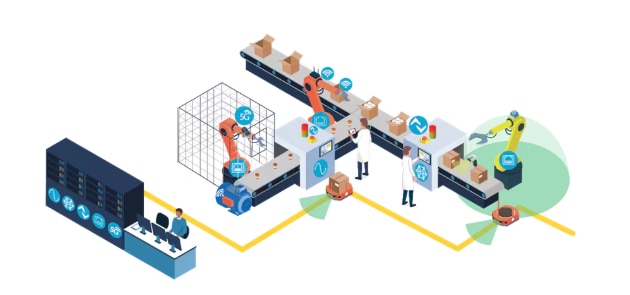by Anders Frederiksen & Margaret Naughton
Welcome to the first installment in our blog series exploring the dynamic world of industrial mobile robots. As industries continue to push the boundaries of automation, mobile robots are becoming essential tools for achieving greater efficiency, flexibility, and scalability in manufacturing environments. This series aims to provide a holistic overview of the design challenges and technology innovations that are driving the evolution of industrial mobile robots – from understanding the right robotic fit for your industrial automation needs, to the exploration of critical topics such as localization, navigation, safety and motion control. Experts draw on ADI’s rich history in industrial automation as well as their comprehensive system level knowledge to explore how key enabling technologies are addressing the challenges faced on the path to more efficient and flexible manufacturing capabilities.
The automation of tasks is becoming commonplace in all facets of our lives. Who hasn’t seen their neighbor out mowing their lawn lately but instead has seen a robotic lawnmower happily moving around the garden keeping the grass at bay. This is just one example of where automation in the form of a mobile robot is freeing humans from repetitive tasks. As much as I love not having to mow my lawn, the real impact of mobile robotics and the automation of tasks is most evident in factories and warehouses. Where constant movement of materials and assets within a manufacturing facility is required, here you see the power of what mobile robots can do.
Autonomous Mobile Robots (AMRs) or Automated Guided Vehicles (AGVs) allow disparate parts of a production process to be connected, they can be the go-betweens for humans or other machines facilitating the handoff from one station to another.

You might wonder “why are mobile robots making more of an impact today?” – the answer is simple; firstly, they are more perceptive. Data-driven insights are making a difference in today’s automation revolution. In a true fusion of sensors, data from 3D time of flight cameras, Inertial Measurement Units (IMUs), Lidar, and many more systems are collected and processed to create a real-time awareness of the robots’ surroundings, seamlessly mapping the environment, and the robot’s location within the factory floor.
Secondly, they are efficient. With advancement in real-time perception comes more freedom, and the ability to move around a dynamically changing environment. Warehouse and factory automation is relying on mobile robotics to improve efficiency, manage inventory, and speed up operations. In large warehouses, the management and movement of inventory is streamlined with mobile robots that can scan, locate, and move equipment and products, to ensure a 24 / 7 level of operation to meet demands for fulfilment, in the case of retail and online shopping. Another key factor is that fully automated factories can operate at lower temperatures and light conditions where humans normally would not work but robots “don’t care”.
With predictable movement comes the added benefit of safety. Having mobile robots transferring materials not only brings efficiency but also removes risks inherently involved in certain tasks. A task performed by a forklift controlled by a human has the potential for injury to the driver, to others in the location, and can be unpredictable in its operation. A mobile robot will consistently choose the most efficient way of getting from point A to point B, it will move slowly to its required location and, in the case, where accidents happen, no human is there to be injured. Some tasks may involve hazardous materials, or interaction with dangerous equipment, these scenarios pose no risk to a mobile robot tasked with transporting that material or getting close to a large piece of moving equipment, unlike a human operator tasked with the same job.
Thirdly, today’s robots are more flexible, they can be programmed for new tasks as the needs arise in processes. With the quest for batch-size-of-one production facilities requiring customized processes, mobile robots that can adapt are vital. The Robot Operating System (ROS) which is a powerful developer tool for driver development has enabled many to begin their robotic journeys. Designing algorithms to bring human-like behavior to a mobile robot and the tasks that it must carry out. It’s a fascinating time to be working in the field of robotics with more standardization, more collaboration, and the digital transformation happening in the industrial world – making mobile and mounted robots capable of understanding the environment, interacting, and communicating like never before.
Intelligence at the edge, improvements in battery management, and seamlessly connected factories are all supporting the deployment of mobile robotics. While some tasks are easier than others to automate, when it comes to the world of Industrial Mobile Robotics, the tasks are more complex, the environments more challenging and the intelligence onboard the robot will be key in its seamless integration into a highly automated manufacturing environment. To learn more visit analog.com/mobile-robotics

